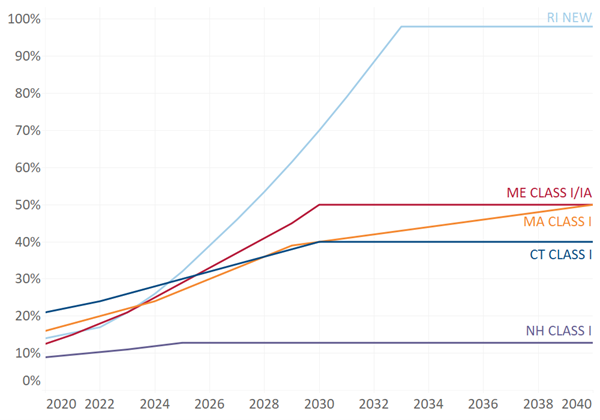
By Simon Pritchard, Manager Director of Analytics and Tarik Cetin, Senior Energy Analyst
A renewable energy certificate (REC) is a type of tradable certificate that represents the environmental attributes or benefits of generating electricity from renewable sources. Also known as a renewable energy credit, each REC represents the environmental attributes associated with the generation of one megawatt-hour of electricity from solar, wind, and other renewable sources. These certificates are tracked and verified by independent third-party organizations to ensure their credibility and accuracy.
RECs were first established in the United States to meet the need for greater renewable energy development in order to expand the share of clean sources in the energy mix, thereby reducing the nation’s contribution to climate change. There are two main markets for RECs – compliance markets and voluntary markets.
Compliance markets were created through a state legislative mechanism called the Renewable Portfolio Standard (RPS), which exists in a slight majority of the U.S. states, including all of the New England states. The RPS requires electricity suppliers to obtain a certain percentage of the electricity they provide from renewable sources. To comply with this requirement, suppliers must retire enough RECs to cover the percentage mandated by the RPS.
Voluntary markets for RECs have also emerged, where individuals, businesses, and organizations voluntarily purchase RECs to support renewable energy projects and reduce their Scope 2 greenhouse gas emissions. These markets allow anyone to contribute to the growth of renewable energy, even if they are not subject to a regulatory mandate. RECs have gained prominence among businesses as sustainability and corporate social responsibility initiatives have become more prevalent. Many companies recognize the importance of reducing their carbon emissions and transitioning to cleaner sources of energy. By purchasing and retiring RECs, businesses can demonstrate their commitment to sustainability, reduce their environmental footprint, and support the development of renewable energy projects. Additionally, growing demand for renewable energy among consumers has also influenced businesses to adopt RECs as a way to meet customer expectations and enhance their brand image. This increasing emphasis on sustainability, combined with the flexibility and transparency of RECs, has made them a popular choice for businesses looking to embrace clean energy without major infrastructure investments.
Compliance Markets
Compliance REC markets affect end users in two ways. The costs that suppliers incur to procure compliance RECs to meet their obligations under RPS laws, are included in the electricity supply rates charged to customers. Therefore, sustained trends in compliance REC pricing may impact an end user’s energy spend. For some end users who own or contract with a renewable energy project that conveys the RECs of the project to the end user, those compliance RECs may be sold to suppliers to improve the economics of those projects.
New England REC markets have remained steady for much of the past year, with a slight rise in Class I (new renewables) pricing towards the end of the 2022 REC trading year continuing to start 2023. Maine has seen more notable movement, as Maine Class I RECs, historically lagging have continued a steady rise in pricing, closing the gap with Class I REC pricing across the rest of New England, as a new RPS law passed in 2019 continues to ramp up demand each year. Meanwhile, ME Class II RECs (older resources, generally large hydroelectric facilities) rose to a high point in January on the back of sustained drought through much of 2022, only to fall as higher precipitation since last fall has increased supply in the market, bringing prices closer to historically typical levels in the low-single digits, and recently passed legislation has capped those prices at $10/REC going forward.
In New England, tightening RPS requirements will continue to ratchet up demand into the future. Last year, Rhode Island passed the most aggressive target in the country, requiring 100% renewable energy by 2033. As shown in Figure 1 below, New England state RPS percentages (excluding New Hampshire) will continue to escalate through 2030.
Figure 1. New Renewable Requirements (“Class I”) by State (% of total generation)

Despite efforts across the region to increase procurement of offshore wind, cost increases, potential contract re-negotiations, and development hurdles, have limited the outlook for significant build-out this decade, suggesting the supply growth of RECs in the region will struggle to keep up with the accelerating targets around the region and keep REC prices elevated through the end of the decade.
In other regions, the supply chain challenges, material cost increases, and permitting slowdowns in building new renewables have already pushed compliance prices considerably. In California, pricing indicators for PCC1 RECs (RECs from new-build, in-state renewables) have nearly tripled since the start of the year, and nearly quadrupled since the start of 2022. Despite aggressive targets of 60% renewable electricity by 2030 and 100% carbon-free electricity by 2045, project development has slowed considerably in recent years, as permitting delays have been exacerbated by supply shortages and rising costs. State efforts to address the slowdown have ramped up, most recently in a set of legislative proposals unveiled in May by Governor Gavin Newsom to streamline permitting processes under the California Environmental Quality Act, as well as construction procurements and judicial project reviews.
Voluntary Markets
In the voluntary REC market, there are two ways RECs are sold: bundled and unbundled. Bundled RECs are sold alongside electricity and are mainly purchased by companies that wish to purchase clean energy through a power purchase agreement (PPA). In contrast, unbundled RECs represent the environmental attributes of the renewable energy produced but not the actual energy. These certificates are sold to separate entities from the electricity, allowing them to match or offset their energy consumption to renewably generated power.
Unbundled RECs are attractive to organizations as they are a relatively more cost-effective and flexible way to offset emissions from electricity consumption. Unbundled RECs are historically cheaper, and buyers have more flexibility in choosing whether to buy locally, nationally, or even globally. Yet it is important to note that purchasing unbundled RECs may not result in building of new renewable energy facilities, thereby reducing claims for additionality. On the other hand, bundled RECs provide a more direct connection to the renewable project, as the purchaser actively supports the development of new renewable energy facilities, and the associated reduction of emissions, by purchasing energy from them, thereby achieving additionality.
There is a growing preference for bundled RECs for this reason. According to the annual disclosure report 2022 of RE100, an initiative bringing together businesses committed to 100% renewable electricity, the share of PPAs in corporate renewable energy procurement more than doubled from 14% in 2016 to 35% in 2021.
Looking forward, REC prices are expected to rise due to a combination of demand and supply-side factors. As corporate participation in the voluntary market grows, demand for and price of RECs are expected to increase. Costs of renewable project development are still above pre-Covid levels in many parts of the world due to factors like supply chain disruptions, inflationary macroeconomic environment, and rising interest rates. According to the International Energy Agency, “global average levelized costs of energy for onshore wind and solar PV are expected to remain 10-15% above 2020 in 2024.” Supply-side factors such as these are expected to result in higher REC prices, especially for bundled RECs that stem from PPAs.
Conclusion
As they continue to impact the cost of electricity supply, the attractiveness of owning RECs from a renewable energy project, and the cost of offsetting emissions from fossil fuel-sourced electricity, keeping track of the REC markets will continue to be worthwhile. Work with your Energy Services Advisor to understand the opportunities to participate in the REC markets to save money and meet your own carbon reduction goals.
